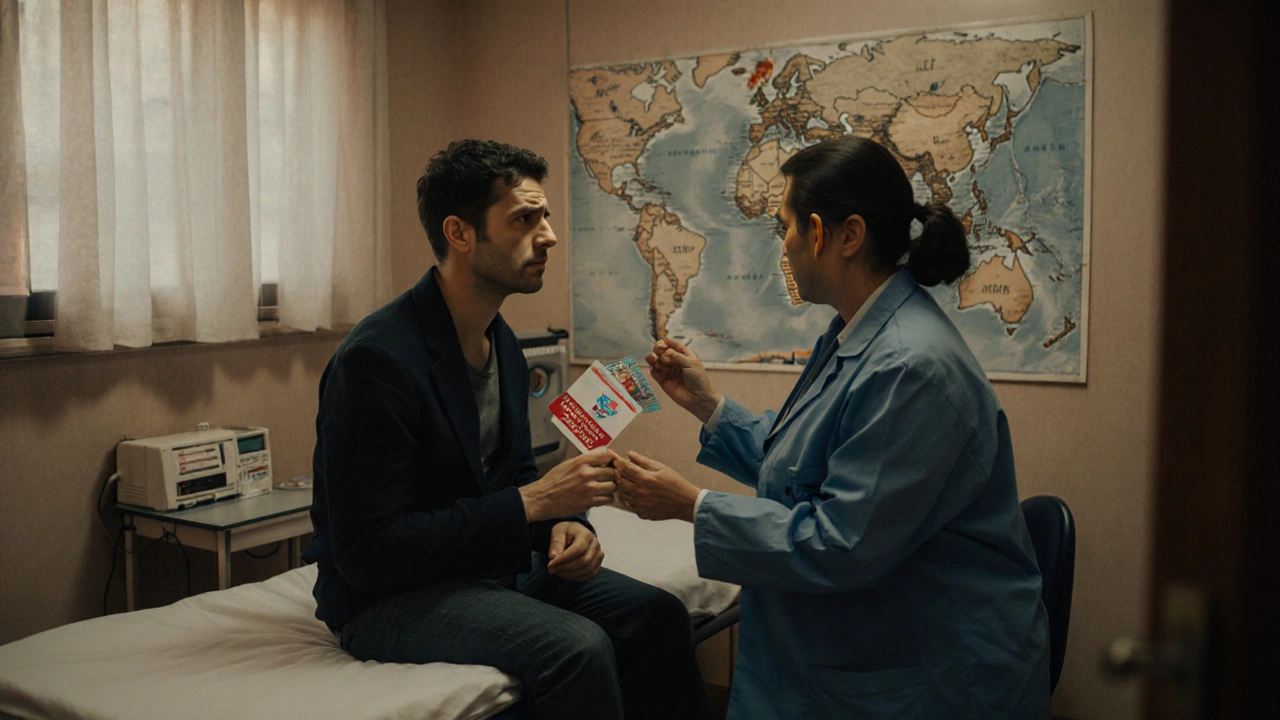Quick Take
- Screen for Hepatitis C before you book a trip.
- Carry a copy of your medical records and medication.
- Never accept injections, tattoos, or piercings from unlicensed providers.
- Know the nearest qualified health center in your destination.
- Stay hydrated, eat well, and keep your immune system strong.
Hepatitis C is a blood‑borne viral infection that attacks the liver and can become chronic if untreated. The virus belongs to the Flaviviridae family and is primarily spread through contaminated needles, blood transfusions before 1992, or unsafe medical procedures.
For travelers, the concern isn’t a new vaccine-there isn’t one yet-but the risk of accidental exposure during a trip. Understanding how the disease spreads and where the hotspots are lets you plan smartly.
Why Travel Changes Your Risk Profile
When you’re on the move, you encounter three main risk amplifiers:
- Medical tourism: seeking cheaper procedures abroad can expose you to unsterilized equipment.
- Adventure activities: tattoos, piercings, or scarification performed in informal settings often skip proper hygiene.
- Unpredictable emergencies: accidents may demand urgent care where infection‑control standards vary.
These scenarios differ from everyday life at home, where regulations and sterility protocols are stricter.
Pre‑Trip Precautions
World Health Organization (WHO) is a United Nations agency that coordinates global health standards, including Hepatitis C surveillance and prevention guidelines. Checking WHO’s latest country‑specific risk bulletin helps you pinpoint high‑risk regions.
Key steps before you leave:
- Get Tested: A simple antibody test can tell if you’ve ever been exposed. If positive, follow up with a RNA test to confirm active infection.
- Consult a Specialist: Talk to a hepatology or infectious‑disease doctor about your travel itinerary.
- Update Vaccinations: While there’s no vaccine for Hepatitis C, getting vaccinated against Hepatitis A and B reduces overall liver‑disease burden.
- Gather Documentation: Carry a printed summary of your diagnosis, current viral load, and a list of prescribed antiviral therapy (e.g., sofosbuvir/velpatasvir). Include dosage, storage needs, and emergency contact numbers.
Precautions While Traveling
The mantra is simple: avoid any exposure to another person’s blood. Here’s how to put that into practice:
- Medical Care: Only receive injections, blood draws, or surgeries at accredited hospitals or clinics. In the U.S., look for Joint Commission accreditation; abroad, ask for ISO‑15189 certification.
- Tattoos & Piercings: Say no to street‑side artists. If you must, verify that single‑use needles are used and that the work area is disinfected with 70% alcohol.
- Dental Work: Choose dental offices that use disposable syringes and autoclaved instruments. Carry a sterile mouth‑rinse to reduce oral bacterial load.
- First‑Aid Kits: Pack a small kit that includes sterile gauze, adhesive bandages, and antiseptic wipes. Replace any opened items before each trip.
- Personal Hygiene: Wash hands frequently, especially after visiting markets or public transport.
CDC (Centers for Disease Control and Prevention) is a U.S. federal agency that issues travel health notices and detailed guidance on Hepatitis C prevention. Their website provides a country‑by‑country risk score you can reference before booking flights.

Managing Existing Hepatitis C on the Road
If you’re already on treatment, continuity is critical. Interruption can lead to viral rebound and resistance.
- Medication Storage: Most direct‑acting antivirals (DAAs) are stable at room temperature (15‑30°C). Keep them in a sealed pouch away from heat and moisture.
- Adherence Tools: Use a smartphone alarm or pill‑box with compartments for each day.
- Local Pharmacy Access: Research whether your medication is available overseas. In many European countries, DAAs are reimbursed and can be obtained with a prescription.
- Emergency Supply: Carry an extra two‑week supply beyond your planned return date.
What to Do If You Suspect Exposure
Accidents happen. If you think you’ve been exposed to contaminated blood:
- Stop the bleeding immediately and clean the wound with soap and water.
- Apply a sterile bandage.
- Seek medical attention at the nearest reputable health facility.
- Ask for a post‑exposure prophylaxis (PEP) protocol. While there’s no proven PEP for Hepatitis C, early monitoring can catch infection before it becomes chronic.
- Document the incident: date, location, and any witnesses.
Follow up with your home‑based hepatologist within two weeks for baseline labs and repeat testing at 4‑6 weeks, 3 months, and 6 months if needed.
Comparison of Hepatitis Viruses for Travelers
| Feature | Hepatitis A | Hepatitis B | Hepatitis C |
|---|---|---|---|
| Transmission | Fecal‑oral (contaminated food/water) | Blood & sexual contact | Blood only; no sexual‑only transmission |
| Vaccine | Yes (2‑dose) | Yes (3‑dose) | No |
| Acute vs Chronic | Acute, self‑limiting | Can become chronic (5‑10% adults) | High chronicity (75‑85%) |
| Treatment | Supportive care | Antivirals (tenofovir, entecavir) | Direct‑acting antivirals (DAAs) |
| Travel Risk | High in low‑sanitation regions | Risk from medical tourism & tattoos | Risk from unsafe injections, medical tourism |
Related Concepts and Resources
Understanding Hepatitis C fits into a broader health‑travel framework:
- Blood‑borne pathogen is a microorganism transmitted through contaminated blood, including HIV, hepatitis B, and hepatitis C.
- Liver disease encompasses conditions like cirrhosis, hepatocellular carcinoma, and fatty liver disease, often resulting from chronic viral hepatitis.
- Safe injection practices, endorsed by both WHO and CDC, call for single‑use needles, proper disposal, and hand hygiene.
- Travel insurance policies that cover pre‑existing conditions and medical evacuation can be a lifesaver.
Next logical reads: "How to Choose a Hepatitis‑Safe Clinic Abroad," "Managing Antiviral Therapy While Backpacking," and "Understanding Liver Health After Viral Clearance."

Frequently Asked Questions
Can I get Hepatitis C from food or water while traveling?
No. Hepatitis C is not spread through ingestion. It requires direct blood contact, so the main food‑related concerns are Hepatitis A and parasites.
Do I need a doctor’s note to bring my antiviral pills across borders?
Most countries allow personal medication with a prescription copy. Carry the note, the original label, and a brief treatment summary to avoid customs delays.
Is there any post‑exposure prophylaxis for Hepatitis C?
Currently, no approved PEP exists. Early testing after exposure, followed by prompt antiviral treatment if infection occurs, is the best strategy.
What should I do if I need emergency medical care in a low‑resource setting?
Insist on using new, sterile equipment. If you can’t verify sterility, request a referral to a higher‑level facility. Document the encounter and follow up with your home physician as soon as possible.
How long should I continue my antiviral regimen after returning home?
Complete the full prescribed course-usually 12 weeks for most DAAs-regardless of travel dates. Skipping doses can lead to treatment failure.


15 Responses
Traveling with Hep C? Make sure you get your test results in hand before you book anything.
Carry a printed copy of your prescription and a brief medical summary – it saves a lot of hassle at customs.
Also, check if the country you’re heading to has any special import rules for medication.
One must acknowledge that the prevailing discourse on Hepatitis C travel safety is riddled with oversimplifications.
While the author enumerates sensible precautions, a discerning traveller should also scrutinise the accreditation of every health facility encountered abroad.
Neglecting such diligence invites an unnecessary cavalcade of risk, an indulgence no connoisseur of global mobility can afford.
Indeed, the risk matrix expands dramatically when one factors in cross‑border variance in ISO‑15189 compliance.
Integrating a pre‑travel risk assessment algorithm can flag facilities that fall below the threshold, thereby streamlining the decision‑making pipeline.
I have to say that the thoroughness of this guide is impressive, and it really resonates with anyone who has ever felt the pang of uncertainty before stepping onto a plane with a pre‑existing condition.
The emphasis on carrying medical documentation cannot be overstated, because border agents often request proof of legitimacy for medication.
Equally important is the reminder to verify the sterility of any equipment used during emergency medical care, a point that many travellers tend to overlook in the excitement of their itinerary.
One also appreciates the inclusion of dental care recommendations, as oral health can unexpectedly become a source of infection if proper protocols are ignored.
The suggestion to pack a miniature first‑aid kit with sterile supplies is both practical and reassuring, especially for those venturing into remote locales.
Moreover, the advice to stay hydrated and maintain a balanced diet underscores the broader principle that a robust immune system is your first line of defence.
It is worth noting that the guidance aligns well with WHO and CDC standards, lending it additional credibility.
Overall, this piece serves as a solid checklist for anyone navigating the complexities of Hepatitis C management on the road.
All these health agencies are just a front for big pharma they want you scared so they sell more drugs
Traveling with Hepatitis C can feel scary but you can stay safe if you plan ahead. First get a blood test and know your viral load before you leave. Write down the name of your medicine, the dose and how to store it. Put this paper in your carry‑on so you can show it at the airport. Look up the health clinics in the city you will visit and make sure they are approved. When you need a shot or a blood draw only go to places that use single‑use needles. If a dentist asks for tools say you only want sterile equipment. Pack a small kit with sterile gauze, bandages and alcohol wipes. Keep your pills in a cool dry bag away from heat. Set an alarm on your phone to remind you to take your dose every day. If you miss a dose set a reminder right away to catch up. Carry a copy of your doctor’s note in case customs asks for it. If you get hurt clean the wound with soap and water before bandaging. Find a pharmacy near your hotel in case you need extra medicine. When you get home tell your doctor what happened and get new blood work to be sure everything is still good.
Great checklist! Keeping a printed note and an alarm on your phone are simple steps that make a huge difference on the road.
Good vibes on this thread – love seeing people actually think about the details before they jet off. I’ve been on a few trips where I had to ask for a fresh needle and the staff were super friendly, which made the whole thing feel less stressful.
Ah, the bittersweet romance of globetrotting with a chronic condition! One must balance the allure of distant horizons with the solemn duty of self‑preservation, lest the adventure turn into a tragic opera of missteps.
Indeed, the juxtaposition of wanderlust and medical vigilance engenders a narrative replete with paradoxical nuance. While the siren call of exotic locales beckons with promises of cultural enrichment, the ever‑present spectre of iatrogenic exposure looms as a cautionary refrain. In this intricate ballet, the traveller must choreograph each movement with meticulous deliberation, ensuring that the symphony of health protocols harmonises with the cadence of exploration. Failure to heed such imperatives may precipitate a cascade of adverse outcomes, the ramifications of which extend beyond the individual to reverberate across familial and societal spheres. Consequently, it is incumbent upon the discerning voyager to embed these safeguards within the very fabric of their itinerary, thereby transforming potential peril into a testament of prudential mastery.
It's refreshing to see such practical advice. Knowing where the nearest ISO‑15189 clinic is can save you a lot of worry if an accident happens.
Exactly, a quick Google search before you leave can map out the top hospitals and even show you patient reviews, so you go in with confidence.
No need to overthink, just stick to clean needles.
Adding to what's been said, many travelers find it handy to download a translation app that includes medical phrases. This way, you can clearly ask for “new, sterile equipment” in the local language, reducing any ambiguity.
Good tip.